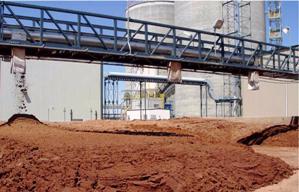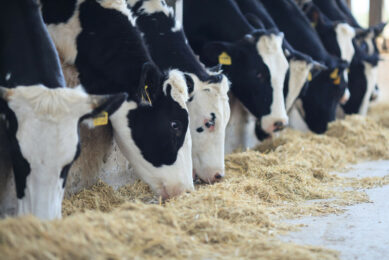Distillers grains: Which residues are we afraid of?

The popularity of Dried Distillers Grains with Solubles (DDGS), the co-product of ethanol production, is increasing in Europe due to a shortage of protein raw materials. But apart from GM-issues, imports also need to be screened for antibiotics, since these products are used in the fermentation process to fight lactic acid bacteria that compete with yeast for the sugars to make ethanol. More alternatives to antibiotics are becoming available though.
Antibiotics are a sensitive subject in animal production. Banned as a growth promoter in Europe since 2006 and strongly discussed in US parliament where congress woman Louise Slaughter (D-NY), on 17 March 2009 introduced the “Preservation of Antibiotics for Medical Treatment Act” (PAMTA) in the House of Representatives. “There is little doubt that antibiotic-resistant diseases are a growing public health menace,” she said. “My legislation will limit the use of antibiotics on our livestock to ensure that we are not inadvertently creating antibiotic-resistant diseases that we can’t fight with modern medicine.” However, science and consumer fear fight for prevalence and two years after introduction there is no real movement on passing the Act.Critics of the livestock industry blame under controlled use of antibiotics in animal operations as the main cause for antibiotic resistance in treatments of human infections. But there is also concern that DDGS as a raw material in animal feeds might attribute to this resistance, since antibiotics are also used in the ethanol fermentation process to keep unwanted bacteria under control that compete with yeast for the sugars to convert.
Production process
Distillers grains are primarily produced through dry or wet milling. However, ethanol producers are continually working to create new distillers grain varieties in order to meet the needs of the livestock industry. When producing distillers grains through dry milling, the whole grain is milled and used for ethanol production. Wet milling, on the other hand, separates out all of the grain components and only uses the starch for ethanol production. The remaining portion of the grain is used to create a variety of other marketable products.With each method, the grain or the starch is added to water to create a mash. The mash is heated and enzymes are added to the mixture which allows the starch to breakdown and form glucose. Next, the mash is fermented. During fermentation, yeast is added to the mixture. The yeast converts the glucose to alcohol. However, during this step bacteria can compete with the yeast, utilising the glucose to grow. This in turn reduces the amount of ethanol produced from the fermentation process. In order to combat these competing bacteria, antibiotics are added to kill the unwanted bacteria and allowing the yeast to utilise all of the glucose. (The industry claims that this way the need to cultivate an additional 3.2 million acres to produce an extra 500 million bushels of corn is eliminated).
Once fermentation is complete and all of the glucose has been converted to alcohol, the alcohol is separated from the water and solids through a distillation column. Here heat and other separation methods remove all water from the alcohol producing 100% pure ethanol.
After distillation all that remains are the solid (wet cake) and liquid (thin silage) components of silage. The silage is made up of protein, fibre, oil and non-fermented starch at a concentration three-fold greater than that in the original corn. Additionally, antibiotic residues from the fermentation will be present. In order to separate the liquid portion of the silage from the solid portion, centrifugation is used. The wet portion, or thin silage, is evaporated further to produce a thick syrup called condensed solubles. The condensed solubles can then be added to the wet cake to produce a variety of products (Table 1). DDGS play a significant role in keeping an ethanol plant afloat financially – on average, sales of DDGS make up about 20% of a plant’s revenue stream. So it is in the interest of the ethanol plant to produce a saleable product without unwanted constituents.
Unwanted effects of antibiotics
The US Food and Drug Administration (FDA) has several concerns with the use of antibiotics in the fuel ethanol industry. Their primary concern is that antibiotic residues may be present in distillers grains and that those residues could be transferred to animal tissue upon ingestion. The FDA is specifically concerned with the probability that consumption of contaminated animal tissues could result in antibiotic resistance in humans. However, it is unlikely that antibiotic residues in distillers grains would transfer into animal tissue due to the low levels present in distillers grains, as well as the pharmacology of the antibiotics used in ethanol production. Many countries currently place maximum residue limits in foodstuffs of animal origin to combat this problem. Finally, the FDA expressed concern for the health of animals fed distillers grains containing antibiotic residues.
It is also suggested that these antibiotic residues in the DDGS may prevent swine manure from improper biological digestion. Currently, studies are in process to determine how the antibiotic residues in the DDGS are affecting the biological life of a manure system. However, it should not be forgotten that many pig producers still use antibiotics in the feed as growth promoters. This may also cause a problem in the pit later since remnants pass through the animal into the manure and limit microbial activity. So, type and level of antibiotic can impact manure bioaugmentation.
Approved products
The only antibiotic currently approved for use in ethanol production is virginiamycin. The product is marketed in the US by Phibro Chem (Lactrol) and Lallemand Ethanol Technology (Lactoside V). The FDA/Centre for Veterinary Medicine (CVM) issued a letter of no objection for the use of virginiamycin in the fermentation phase of alcohol production at 2 to 6 ppm. In addition, the CVM did not object to potential residues of 0.2 to 0.5 ppm in distillers by-products. This statement was based on an animal diet containing no more than 20% distillers grains. Moreover, it was stated that the FDA/CVM is unlikely to take regulatory action against dried distillers grains-containing feed with residual levels of virginiamycin below 0.5 ppm. Levels below 0.5 ppm pose no concern to broilers, turkeys, swine, or cattle consuming the feed, or to the humans consuming food derived from those animals. DDGS from plants that used virginiamycin in their process is found to be Generally Recognized as Safe (GRAS) by expert panels.
Although antibiotic residues have been confirmed in distillers grains by the FDA, the activity level of those residues has never been tested. It is possible that the residues present have been inactivated by the ethanol production process, as the antibiotics are exposed to high and low temperatures and a wide pH range. In 2008, the FDA tested 60 DDGS samples for residues of virginiamycin, tylosin and erythromycin. Of the 45 samples analysed, 24 came back positive. Fifteen of the samples contained residues of virginiamycin, 12 contained residues of erythromycin, and five contained residues of tylosin. Some were detected at levels considered significant, according to the FDA, including residue levels exceeding 0.5 ppm. The organisation did not comment on what their study results might mean for human and animal health and has not made their study results public. Sampling and testing by the FDA continues. “Our 2010 sampling assignment continues and is likely not to be completed until the end of 2010/early 2011,” said Laura Alvey, communications director for the CVM. Alvey also said CVM would wait to comment on the survey until “we have had time to thoroughly review any/all results.” Until now, the industry is still waiting.
Alternatives
Not all ethanol production facilities are using antibiotics to control bacteria in their fermentation tanks. Some plants use ingredients made from brewing hops and many others use chlorine dioxide to control the bacteria. Whether these alternatives can compete with virginiamycin in effectiveness and costs, is unknown.
Stabilised chlorine dioxide (Fermasure from DuPont, PureMash from Resonant BioSciences) is actually buffered sodium chlorite, a salt with antimicrobial properties activated by the fermenter’s own bacteria. The acidic nature of the bacteria converts the sodium chlorite to chlorine dioxide, a powerful disinfectant used frequently in water treatment facilities, which degrades to a non-toxic residue of chloride and sodium ions (salts). No free chlorine or dioxins are produced in the process.Stabilised chlorine dioxide isn’t the only alternative. Several producers have switched from antibiotics to a product derived from hops, the same type of hops used in breweries. Hops extract is a natural antimicrobial, and the makers of IsoStab (made by BetaTec, Inc.) say that their hops acid lowers the pH of the bacteria cells and as such inhibits the cell’s ability to transfer glucose through its cell wall. In essence bacteria are starved to death. It is also claimed that hops extract enhances the performance and vitality of yeast and improves production conditions to make commercial fermentation processes more efficient.A number of other antimicrobials have gone on the market recently or are under development, offering ethanol producers several effective, economical alternatives to antibiotics.When ethanol producers refrain from using antibiotics they will be able to market their DDGS as “antibiotic-free,” a term that will play well with DDGS customers who have become more concerned now as multi-resistant bacteria in hospitals makes headlines in newspapers, although there is no relation to ethanol production. Therefore antibiotic-free is also a qualification that is necessary for any producer hoping to export DDGS to Europe. AAF
Hops acids |











